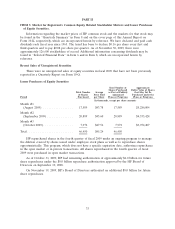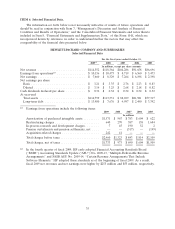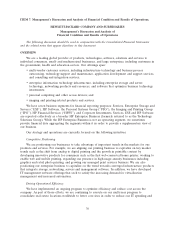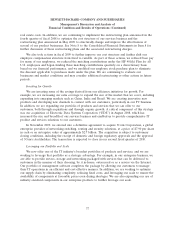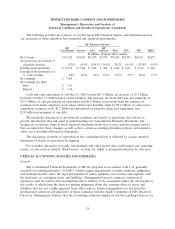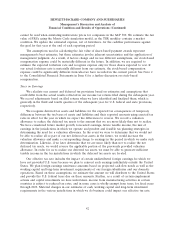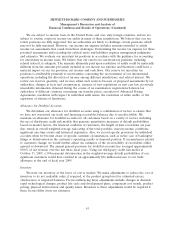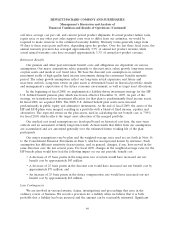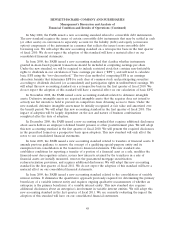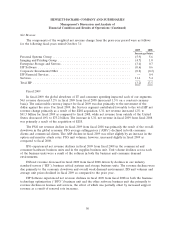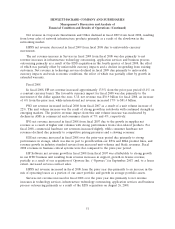HP 2009 Annual Report Download - page 48
Download and view the complete annual report
Please find page 48 of the 2009 HP annual report below. You can navigate through the pages in the report by either clicking on the pages listed below, or by using the keyword search tool below to find specific information within the annual report.HEWLETT-PACKARD COMPANY AND SUBSIDIARIES
Management’s Discussion and Analysis of
Financial Condition and Results of Operations (Continued)
purchased intangible assets recorded by us include customer contracts and lists, developed and core
technology and the Compaq trade name. The fair values assigned to the identified intangible assets are
discussed in detail in Note 7 to the Consolidated Financial Statements in Item 8.
Critical estimates in valuing certain intangible assets include but are not limited to: future expected
cash flows from customer contracts, customer lists, distribution agreements, and acquired developed
technologies and patents; expected costs to develop IPR&D into commercially viable products and
estimating cash flows from projects when completed; Compaq brand awareness and market position, as
well as assumptions about the period of time the brand will continue to be used in our product
portfolio; and discount rates. Management’s estimates of fair value are based upon assumptions
believed to be reasonable, but which are inherently uncertain and unpredictable and, as a result, actual
results may differ from estimates.
Other estimates associated with the accounting for acquisitions may change as additional
information becomes available regarding the assets acquired and liabilities assumed, as more fully
discussed in Note 6 to the Consolidated Financial Statements in Item 8.
Restructuring
We have engaged, and may continue to engage, in restructuring actions, which require
management to utilize significant estimates related to expenses for severance and other employee
separation costs, realizable values of assets made redundant or obsolete, lease cancellation and other
exit costs. If the actual amounts differ from our estimates, the amount of the restructuring charges
could be materially impacted. For a full description of our restructuring actions, refer to our discussions
of restructuring in the Results of Operations section and Note 8 to the Consolidated Financial
Statements in Item 8, which are incorporated herein by reference.
Stock-Based Compensation Expense
We recognize stock-based compensation expense for all share-based payment awards, net of an
estimated forfeiture rate. We recognize compensation cost for only those shares expected to vest on a
straight-line basis over the requisite service period of the award.
Determining the appropriate fair value model and calculating the fair value of share-based
payment awards requires subjective assumptions, including the expected life of the share-based payment
awards and stock price volatility. We utilize the Black-Scholes option pricing model to value the stock
options granted under our principal option plans. To implement this model, we examined our historical
pattern of option exercises to determine if there were any discernable activity patterns based on certain
employee populations. From this analysis, we identified three employee populations to which to apply
the Black-Scholes model. We determined that implied volatility calculated based on actively traded
options on HP common stock is a better indicator of expected volatility and future stock price trends
than historical volatility. Therefore, expected volatility used in the Black-Scholes option pricing model
in fiscal years 2009, 2008 and 2007 was based on market-based implied volatility.
We issue performance-based restricted units (‘‘PRUs’’) representing hypothetical shares of HP
common stock. Each PRU award reflects a target number of shares that may be issued to the award
recipient. We determine the actual number of shares the recipient receives at the end of a three-year
performance period based on results achieved versus goals based on our annual cash flow from
operations as a percentage of revenue and average total shareholder return (‘‘TSR’’) relative to the
S&P 500 over the performance period. We use historic volatility for PRU awards as implied volatility
41




